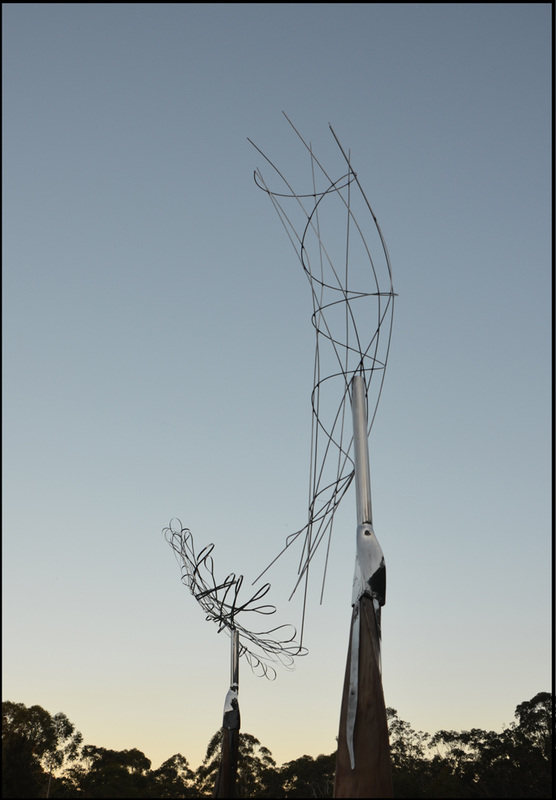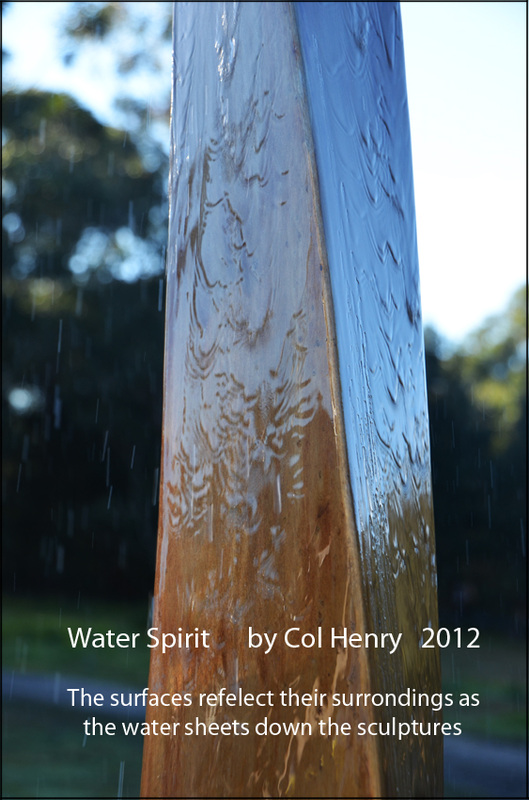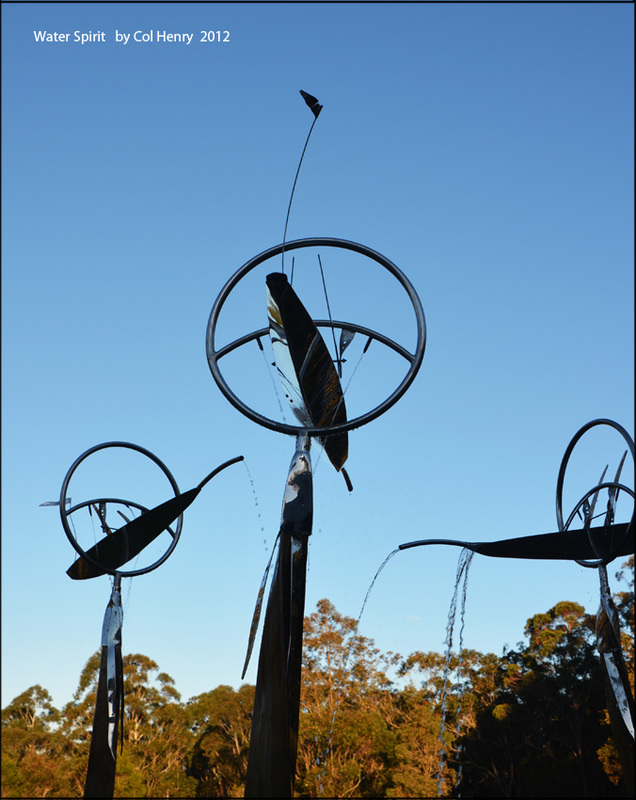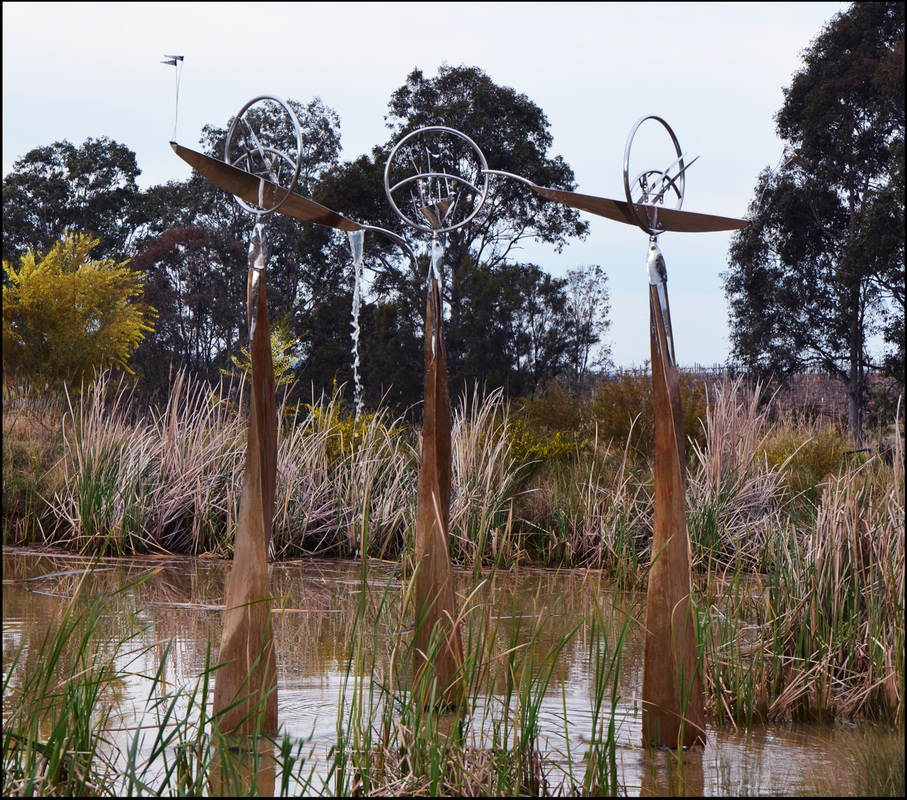ABSTRACT SCULPTURE. Col Henry – Sculptor September 2012
ABSTRACT ART - two words that independently have many meanings, depending on the viewers point of view, culture or life experiences. Together, the permeations are exponentially greater and far more unpredictable.
Abstraction, assumes that reality is progressively removed, while Art can be viewed in many subjective ways.
Abstract Sculpture, lifts the potential of unpredictability with its multitude of facets and perceived realities. It expects the viewer to understand a clear and precise dialogue, being the 'Language of Sculpture', allowing the telling of a story, mostly contrived by the viewer.
This language is a natural instinct, understanding and recognising many forms and shapes, deep in our sub conscious, that help to govern our lives, protect us from danger and even fall in love. It can be informed by years of fashionable trends, presenting ideas and concepts in new and innovative ways, and is often coloured by ones emotive state at the time of contemplation.
Emerging Artists, as well as audiences, may gain an insight into the complexities of understanding abstract work by using the following specific points to deconstruct the makeup and conceptual value of a work. These point touch on the edges of a vast awareness required to comprehensively understand the complexity of abstract sculpture.
A central premise is that the ‘Language of Sculpture’ is an inherent part of human understanding, and is understood by all people, even if in a basic way, as a small child can understand a request without talking or knowing the spoken word.
Many Artist over millennium have describe their vision through sculpture, and the value to their community has been exceptional. The ‘Venus of Willendorf’ is a prime example of art emphasising an important societal belief. The work shows a powerful reference to fertility and could be describe as abstraction.
Through the years, many Artist have described their thoughts with sculpture, introducing more ‘words’ to the vocabulary. Picasso with his extraordinary break from tradition, Hepworth controversially introducing ‘The Hole’ and Rodin with his deliberate exaggerations, touch on the many examples.
Movement, and the tension shown by this, is an important ‘word’ in the language, helping to describing the mood of a work. It is interesting to contemplate that if a dancer is positioned in a ‘off balance attitude’, the viewer can anticipate the direction and speed of the dance over the next few seconds. This instinctive knowledge can be transferred to a sense of movement in sculpture. The most abstract sculptural work, if presented in a ‘off balance attitude’, can describe danger, speed and movement, even though the work by nature is static. A contemplative work may be presented in a ‘still way’ obvious to the viewer, there by setting the theme for the audience to describe the work within their realities.
The idea that danger can be relayed visually is also a powerful tool used by the sculptor. Sharp edges, strong forms and works that seem to threaten their audience, are deliberate methods to raise an awareness and this emotive feeling within the viewer.
A figurative work, to describe a mothers love, or looking for inspiration, can easily be describe by the attitude or positioning of the subjects, with the obvious ‘glance upwards’ conjuring feelings and emotions of looking for inspiration in the viewer. Good abstract sculpture taps into this primal understanding, by presenting a work that is the essence of the intended emotion described within a work.
Symbolic reference is often used to set a base line for the theme. A star form may well be used to connect to a religious theme, while a crescent moon may be a conduit to thoughts on fertility, a new beginning or, a warriors blade. The most interesting point being, that a response from a viewer may well be unpredictable.
Art has been traditionally used to document important historic events or reinforce a popular moral codes. Artists where often though of as philosophers, and deep thinkers, questioning standards and moral codes. The explosion of technology and social media has lessened the Artists’ need and opportunity to dictate the norms of society. It seems that many contemporary and extraordinary Artists are neither interested or deliberate in dictating their opinions. A large cross section of modern Artists are more interested in innovations, relating to visual effects that stimulate the audience to participate in unpredictable dialogue that may then result in possible change.
There are many examples of great public abstract sculpture where the Artist has simply used their artistic talents, with no preordained theme or meaning. This may well be described as true abstraction, where ‘the reality is progressively removed’.
Some other more domestic guidelines to understanding abstract sculpture add to this discussion, but subjectivity, preconceived ideas, and life experiences may also dominate the interpretation.
‘Taking up Space without taking up Space’, is a recent intriguing and developing theme being explored by the author. The basic concept deals with the use of negative space, the areas that do not actually form the work, becoming as important, if not more important than the positive space. An example is shown in the above image where an element of the works describes in an abstract way, the collection and movement of water. The blue water drops move by gravity into the collector, and spiral through this container, to be used, hopefully in a sustainable manner. The image shows a close up of one of the three element of the work known as ‘Sun, Wind and Rain’, and plays with the concept of sustainability. The second image, at the end of the document, shows kinetic detail to articulate the movement of the breeze. Fine spring stainless steel wires move unpredictable in the wind, creating a changing and interesting art-board, influencing the viewer to generate a story, their story, hopefully about the ‘Wind’.
To often, abstract sculptures are simply a collection of found objects. ‘Value added’ by the actual connection of unrelated objects to allow the Artists vision to relate to the audience. The concept of ‘value adding’ can be explained by a simple story of an egg, sold at the farm gate for a small amount of money. If that egg was changed by combining it with flour to make a cake, the product would then be worth more than its real value, and if that cake had an icing applied with small figures of a bride and groom, it may then be worth much more, not only in a monetary way, but by connecting that historic and life changing event to that simple egg, increasing the intrinsic value. This simple formula can be used in an abstract sculpture to take the content of the work ‘out of context’ to increase its intrinsic, physical, and monetary value far in excess of the simple components that are used to create the work.
Value adding can be applied to the development of any sculptures.
Development is another area of deconstruction that must be accessed to have a fair and educated understanding of any works. To create a work from an original sketch or maquette exactly, denies the growth of concept, and will leave the work with an aura lacking in lustre and life. Growth is an essential component of any artwork. The idea that a work should be considered as an adult, while still in its infancy, defies the laws of nature, with growth come maturity, and that maturity is often the standout indescribable feature of any good artwork.
This development stage must also question ‘Honesty in Abstraction’. A difficult concept to explain, but an important criteria. This term ‘Honesty’ refers to the undeniable features that are the essence of a proposed and developing work.
If an abstract work is about flight, the abstraction should relay that message. If the story is about escaping danger, it should display a quality that clearly suggests the fear and risks involved in that reality. To represent an abstract work about flight and escape, by showing a peaceful and resting work and attitude, denies the honest truth about the work. This concept is often confusing, but when the ‘light is on’ the truth ‘glows in the dark’.
Ownership is an element of any work that must also be considered to ensure the longevity of a work. Often a work that is displayed in a public place can polarise a community. Some hate the work, while others love and admire it. There is a theory that time allows acceptance of most things, and a classic urban myth has offered suggesting that when complaints are made relating to a change, for example, the commissioning of a public sculpture, that these complaints are answered in the first instance by an acknowledgment message, and then, one year later a follow up message asking for further complaints. It is purported that at that time of the second request, the original complainant generally requests that the change should stay in place, and insists that the original complaint is now resolved. Death is a good example, where the immediate shock can cause enormous heartache, but with the passing of time, the intensity lowers, and acceptance prevails. This does not mean that the event is not honoured or remembered, but more that the participants learn to accept change.
There are many other criteria to consider while a work evolves, including the use of appropriate materials, the delicacy of creating a work that has a lightness and simplicity that denies the complication of OHS requirements and engineering restrictions. Symbolic references, may need to consider the target audience, and the general theme may need to comply with laws and guidelines set by society and governments.
Abstract Sculpture is a popular art-form with many talented Artists worldwide, creating new and inspiring works. Contemporary works include the exploration of many new technological advances in both materials and application. It is expected that modern abstract sculpture will become more accessible, more acceptable and much more exciting, but always require the ‘shock of the new’, to become the ‘norm for the day’.
Col Henry has practiced sculpture for over 40 years, promoting sculpture in many ways including, teaching in his studio for over 25 years, supporting community groups to gain an acceptance of the art form and mentoring emerging artists.
His passion has led him to develop many new and innovative methods and techniques to create his diverse and size variant body of works.
He has many educational accreditations and achievements, but believes that from education, comes maturity, confidence and independence. Formal education is the apprenticeship, and life, is the mixing bowl, where possibilities are endless, and probabilities are prolific. The ability to transfer ones education and knowledge to find the new, and combining many other life changing events, stands out as the most important feature in his growth as an Artist.
He is known as an innovator, not an imitator, and enjoys the complexity of designing, developing and creating new sculptural works for no other reason than he can.
More information, images of previous works, CV and his Latest News are listed in his web site. www.colhenry.com
Other images at the end of this document show a recent kinetic work that uses symbolic reference, kinetic movement, sound, varied surface texture, elegant form and awareness of the installation site to allow the audience to be involved at many levels, while allowing an ambiguity that conjures stories form the viewers reality.
‘Water Spirit’, constructed from various types of stainless steel, standing over 4 meters tall, using recycled water to enhance the overall ambience.
ABSTRACT ART - two words that independently have many meanings, depending on the viewers point of view, culture or life experiences. Together, the permeations are exponentially greater and far more unpredictable.
Abstraction, assumes that reality is progressively removed, while Art can be viewed in many subjective ways.
Abstract Sculpture, lifts the potential of unpredictability with its multitude of facets and perceived realities. It expects the viewer to understand a clear and precise dialogue, being the 'Language of Sculpture', allowing the telling of a story, mostly contrived by the viewer.
This language is a natural instinct, understanding and recognising many forms and shapes, deep in our sub conscious, that help to govern our lives, protect us from danger and even fall in love. It can be informed by years of fashionable trends, presenting ideas and concepts in new and innovative ways, and is often coloured by ones emotive state at the time of contemplation.
Emerging Artists, as well as audiences, may gain an insight into the complexities of understanding abstract work by using the following specific points to deconstruct the makeup and conceptual value of a work. These point touch on the edges of a vast awareness required to comprehensively understand the complexity of abstract sculpture.
A central premise is that the ‘Language of Sculpture’ is an inherent part of human understanding, and is understood by all people, even if in a basic way, as a small child can understand a request without talking or knowing the spoken word.
Many Artist over millennium have describe their vision through sculpture, and the value to their community has been exceptional. The ‘Venus of Willendorf’ is a prime example of art emphasising an important societal belief. The work shows a powerful reference to fertility and could be describe as abstraction.
Through the years, many Artist have described their thoughts with sculpture, introducing more ‘words’ to the vocabulary. Picasso with his extraordinary break from tradition, Hepworth controversially introducing ‘The Hole’ and Rodin with his deliberate exaggerations, touch on the many examples.
Movement, and the tension shown by this, is an important ‘word’ in the language, helping to describing the mood of a work. It is interesting to contemplate that if a dancer is positioned in a ‘off balance attitude’, the viewer can anticipate the direction and speed of the dance over the next few seconds. This instinctive knowledge can be transferred to a sense of movement in sculpture. The most abstract sculptural work, if presented in a ‘off balance attitude’, can describe danger, speed and movement, even though the work by nature is static. A contemplative work may be presented in a ‘still way’ obvious to the viewer, there by setting the theme for the audience to describe the work within their realities.
The idea that danger can be relayed visually is also a powerful tool used by the sculptor. Sharp edges, strong forms and works that seem to threaten their audience, are deliberate methods to raise an awareness and this emotive feeling within the viewer.
A figurative work, to describe a mothers love, or looking for inspiration, can easily be describe by the attitude or positioning of the subjects, with the obvious ‘glance upwards’ conjuring feelings and emotions of looking for inspiration in the viewer. Good abstract sculpture taps into this primal understanding, by presenting a work that is the essence of the intended emotion described within a work.
Symbolic reference is often used to set a base line for the theme. A star form may well be used to connect to a religious theme, while a crescent moon may be a conduit to thoughts on fertility, a new beginning or, a warriors blade. The most interesting point being, that a response from a viewer may well be unpredictable.
Art has been traditionally used to document important historic events or reinforce a popular moral codes. Artists where often though of as philosophers, and deep thinkers, questioning standards and moral codes. The explosion of technology and social media has lessened the Artists’ need and opportunity to dictate the norms of society. It seems that many contemporary and extraordinary Artists are neither interested or deliberate in dictating their opinions. A large cross section of modern Artists are more interested in innovations, relating to visual effects that stimulate the audience to participate in unpredictable dialogue that may then result in possible change.
There are many examples of great public abstract sculpture where the Artist has simply used their artistic talents, with no preordained theme or meaning. This may well be described as true abstraction, where ‘the reality is progressively removed’.
Some other more domestic guidelines to understanding abstract sculpture add to this discussion, but subjectivity, preconceived ideas, and life experiences may also dominate the interpretation.
‘Taking up Space without taking up Space’, is a recent intriguing and developing theme being explored by the author. The basic concept deals with the use of negative space, the areas that do not actually form the work, becoming as important, if not more important than the positive space. An example is shown in the above image where an element of the works describes in an abstract way, the collection and movement of water. The blue water drops move by gravity into the collector, and spiral through this container, to be used, hopefully in a sustainable manner. The image shows a close up of one of the three element of the work known as ‘Sun, Wind and Rain’, and plays with the concept of sustainability. The second image, at the end of the document, shows kinetic detail to articulate the movement of the breeze. Fine spring stainless steel wires move unpredictable in the wind, creating a changing and interesting art-board, influencing the viewer to generate a story, their story, hopefully about the ‘Wind’.
To often, abstract sculptures are simply a collection of found objects. ‘Value added’ by the actual connection of unrelated objects to allow the Artists vision to relate to the audience. The concept of ‘value adding’ can be explained by a simple story of an egg, sold at the farm gate for a small amount of money. If that egg was changed by combining it with flour to make a cake, the product would then be worth more than its real value, and if that cake had an icing applied with small figures of a bride and groom, it may then be worth much more, not only in a monetary way, but by connecting that historic and life changing event to that simple egg, increasing the intrinsic value. This simple formula can be used in an abstract sculpture to take the content of the work ‘out of context’ to increase its intrinsic, physical, and monetary value far in excess of the simple components that are used to create the work.
Value adding can be applied to the development of any sculptures.
Development is another area of deconstruction that must be accessed to have a fair and educated understanding of any works. To create a work from an original sketch or maquette exactly, denies the growth of concept, and will leave the work with an aura lacking in lustre and life. Growth is an essential component of any artwork. The idea that a work should be considered as an adult, while still in its infancy, defies the laws of nature, with growth come maturity, and that maturity is often the standout indescribable feature of any good artwork.
This development stage must also question ‘Honesty in Abstraction’. A difficult concept to explain, but an important criteria. This term ‘Honesty’ refers to the undeniable features that are the essence of a proposed and developing work.
If an abstract work is about flight, the abstraction should relay that message. If the story is about escaping danger, it should display a quality that clearly suggests the fear and risks involved in that reality. To represent an abstract work about flight and escape, by showing a peaceful and resting work and attitude, denies the honest truth about the work. This concept is often confusing, but when the ‘light is on’ the truth ‘glows in the dark’.
Ownership is an element of any work that must also be considered to ensure the longevity of a work. Often a work that is displayed in a public place can polarise a community. Some hate the work, while others love and admire it. There is a theory that time allows acceptance of most things, and a classic urban myth has offered suggesting that when complaints are made relating to a change, for example, the commissioning of a public sculpture, that these complaints are answered in the first instance by an acknowledgment message, and then, one year later a follow up message asking for further complaints. It is purported that at that time of the second request, the original complainant generally requests that the change should stay in place, and insists that the original complaint is now resolved. Death is a good example, where the immediate shock can cause enormous heartache, but with the passing of time, the intensity lowers, and acceptance prevails. This does not mean that the event is not honoured or remembered, but more that the participants learn to accept change.
There are many other criteria to consider while a work evolves, including the use of appropriate materials, the delicacy of creating a work that has a lightness and simplicity that denies the complication of OHS requirements and engineering restrictions. Symbolic references, may need to consider the target audience, and the general theme may need to comply with laws and guidelines set by society and governments.
Abstract Sculpture is a popular art-form with many talented Artists worldwide, creating new and inspiring works. Contemporary works include the exploration of many new technological advances in both materials and application. It is expected that modern abstract sculpture will become more accessible, more acceptable and much more exciting, but always require the ‘shock of the new’, to become the ‘norm for the day’.
Col Henry has practiced sculpture for over 40 years, promoting sculpture in many ways including, teaching in his studio for over 25 years, supporting community groups to gain an acceptance of the art form and mentoring emerging artists.
His passion has led him to develop many new and innovative methods and techniques to create his diverse and size variant body of works.
He has many educational accreditations and achievements, but believes that from education, comes maturity, confidence and independence. Formal education is the apprenticeship, and life, is the mixing bowl, where possibilities are endless, and probabilities are prolific. The ability to transfer ones education and knowledge to find the new, and combining many other life changing events, stands out as the most important feature in his growth as an Artist.
He is known as an innovator, not an imitator, and enjoys the complexity of designing, developing and creating new sculptural works for no other reason than he can.
More information, images of previous works, CV and his Latest News are listed in his web site. www.colhenry.com
Other images at the end of this document show a recent kinetic work that uses symbolic reference, kinetic movement, sound, varied surface texture, elegant form and awareness of the installation site to allow the audience to be involved at many levels, while allowing an ambiguity that conjures stories form the viewers reality.
‘Water Spirit’, constructed from various types of stainless steel, standing over 4 meters tall, using recycled water to enhance the overall ambience.





